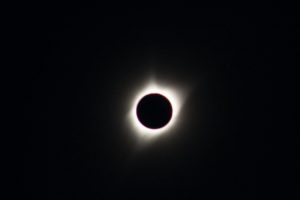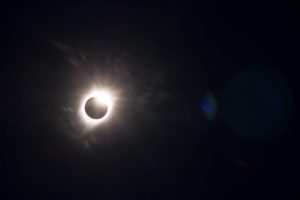Why did I pick Oregon?
I wanted a trip that could be done in a quick three-day weekend, which eliminated all of the South/East. I researched the path of totality and narrowed it down to several places that I have wanted to visit, which also have other areas of interest nearby. I figured that if by chance, the sky was cloudy for the eclipse, at least I would have good memories from other sites. I also researched where was likely to have good weather, to give me the best possible chance of seeing the eclipse. I settled on Oregon and decided I would see Crater Lake in the couple days prior to the eclipse. Still 10 months out, it was very difficult to find a place to stay and I scrambled to find a nice vacation rental in Bend, Oregon.
Total Eclipses are different
I heard this comment frequently leading up to the eclipse, “I’ve seen an eclipse before.” Trust me, if you haven’t seen a total solar eclipse, you haven’t seen anything.
First, let me explain the different types of eclipses. A lunar eclipse is the earth between the sun and a full moon. You stare at the full moon (at nighttime), and as the earth blocks the sun’s light, a shadow appears on the moon, causing it to look like a red glow. This color is caused by light filtering through the earth’s atmosphere.


Next, you have a solar eclipse, which is a new moon, passing between the earth and the sun. You stare at the sun (during daytime, with filters!) and the moon covers all or part of it, to block light and make the sun appear like a crescent.
Partial eclipse is when the sun is only partially covered because of the path of the moon, or because of the angle you are looking at it.
An annular solar eclipse is when the moon covers the sun completely, but because the moon is farther away from the earth (its orbit is elliptical not circular), the sun still shines around it.
A total solar eclipse is when the moon is closer to the earth and blocks out the suns light completely, leaving darkness.
I’ve seen lunar eclipses, and partial solar eclipses. But NOTHING could prepare me for seeing totality. Anything other than a Total Solar Eclipse are just varying degrees of a partial eclipse. I had read articles on what to expect with light and sounds and other phenomenon that happen during an eclipse. And, I did see/feel those things. But the first-hand experience is indescribable.
“Trying to explain what seeing a total eclipse is like is like trying to explain what sex is to a virgin. You won’t understand it until you see it.” – Astrophysicist Fred Espenak in 2017
What happens during a total solar eclipse
The first thing I noticed was the temperature cooling. Much like stepping into shade, when you feel a noted difference. We went from the hot direct sunlight, to feeling a slight chill.
Then, the light around us started to dim. But it’s not like sunrise and sunset, where the shadows get long and there’s a golden glow. The light just seemed to dull from vibrant sunlight to muted hues. Toward the end, it felt like more of moonlight, from a very bright moon. I was surprised how much light the sun produced even until the very last sliver was gone. It was still enough light to read by, and the sky was darkening to a deep blue.
Then suddenly, the moon covers the last bit and it’s like the lights go out. As much as I was anticipating this moment for the past hour and last several months, your body is just not ready for this. It goes against everything your earthly being has ever known. It’s viscerally shocking, and you let out an uncontrollable gasp! I’d heard audio tapes of people watching an eclipse and their reactions sounded exaggerated or overly-dramatic. I couldn’t help but gasp in unison with everyone else, “OH MY GOD!” You know it’s natural and will end in a few minutes, but you’re transfixed by this black hole in the sky. It’s not as dark as midnight, there is a pinkish glow around the horizon (maybe like sunset, but all around you). And you can see some bright stars/planets.
And then, when the sunlight breaks on the other side of the moon, everyone exclaims with relief, “WOW! There it is.” I’ve never felt such a connection to the sun before this day, when it was thrust upon me that we are all children of the sun. It’s not until it is removed from you that you feel the pull, the attachment, the dependency. The only word I can use to describe the experience is magic. Very few moments in my life can be described as magical, but this is definitely one of them.
And of course, like any truly unforgettable experience, we immediately yearn for more. If someone told you that you could feel magic again, and there’s a specific time and place for it, you suddenly feel addicted. Yes, more, I want more. I’ve reveled with other people who witnessed totality, and we are all quite giddy, reminiscing the eerie experience and wondering how or when we will see another. I now consider myself a sun-chaser.



